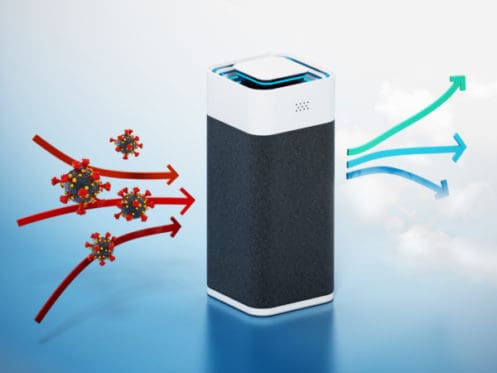Air quality is one of those things that you don’t even think about until there’s a problem with it. Unfortunately, these problems aren’t always obvious or immediate. Air quality can diminish over time, and it can cause health hazards that aren’t noticeable until after the symptoms begin. Poor air quality can also be caused by a number of issues that range from warped furnaces to clogged air conditioner filters, so it can be difficult to pinpoint its source.
The good news is that preventative maintenance of your home’s HVAC systems can help you identify, diagnose, and repair air quality issues before they become major problems. Consider this your all-in-one guide to maintaining a high standard of air quality.
How to Define Air Quality
Indoor air quality (IAQ) isn’t just a vague concept of the oxygen all around you. It’s a metric that can be measured based on many different factors, including:
- Temperature
- Humidity
- Ventilation
- Presence of mold and mildew
- Presence of gases, including carbon monoxide
- Exposure to chemicals
You’ll also see the term “volatile organic compounds” (VOCs) in discussions of indoor air quality. This is a broad category of harmful chemicals that can be produced by everything from paints to pharmaceuticals, so they’re often detected in buildings, including personal homes.
The U.S. Environmental Protection Agency has no official standards regarding indoor air quality, but it does recommend caution and vigilance in keeping it clear.
Symptoms of Poor Indoor Air Quality
Diminished air quality can lead to a number of health problems, including potentially fatal ones. The most obvious symptoms of poor air quality are related to the respiratory system. You might have difficulty breathing, or you might start coughing, sneezing, or wheezing. You might have tightness in your chest or shortness of breath. If you have asthma, you might suffer an attack. These symptoms will be most apparent when you’re directly exposed to a pollutant, but they can linger even after you’ve left the room or house. If exposure to a toxic chemical has damaged your lungs, for example, that damage will keep causing health problems for you even if you escape its source.
Other signs of poor air quality can mimic a cold or flu. Here are a few common symptoms:
- Itchy, watery eyes
- Headaches
- Fatigue
- Dizziness
- Difficulty sleeping
- Skin irritation, including rashes and dryness
- Nausea
Some reactions to VOCs can also cause allergy-like symptoms, which can be hard to recognize if you’re already prone to things like hay fever. Pay attention if your allergies are sticking around even in the off-season.
HVAC Issues That Can Cause Poor Air Quality
In addition to everyday pollutants, your HVAC system can be the cause of air quality issues. The most common culprits are clogged filters. This applies to both furnace and air conditioner filters. If you haven’t changed them in a while, they’ve probably gotten dirty, which will result in poor airflow through your ducts as well as contaminants lingering in the home rather than being properly filtered.
Another potential issue is ventilation. The ductwork around your house is a complex and surprisingly delicate system, and it can be disrupted by everything from leaky valves to worn-out pumps and vents. In the winter, these elements can frost; in the summer, they can melt and warp. When your ductwork isn’t operating properly, this opens the door for toxins and pollutants to join the air circulating throughout your home. Other hazards can include things like backdrafting, which is when gases from fuel-burning appliances get accidentally recirculated into the house rather than safely exhausted outdoors.
Relatedly, you’ll want to be on the lookout for the consequences of broken HVAC parts and systems. If you’ve ordered any repairs lately, you’ll want to double-check that the bad parts weren’t causing air quality issues before they were fixed. Both heating and cooling units can be the sources of everything from bad odors to smoke and fine particles in the air.
How to Check Your Indoor Air Quality
If you suspect a problem with your home’s air quality, there are several ways to investigate. One of the easiest ways to check air quality is to install an air quality monitor. Depending on the model that you buy, you can track everything from your home’s temperature and humidity levels to its baseline exposure to toxins. Some monitors use things like electrochemical sensors to determine how many pollutants are in the air; others use infrared lights to measure how much gas or particulate matter passes by within a specific time frame.
If you suspect the presence of a particular toxin, you might be able to buy a monitoring device for it specifically. For example, carbon monoxide detectors can stand guard against CO at all times.
Another way to check up on indoor air quality is to run a test. Do you notice weird spots on your bathroom wall? A mold test can collect a few samples and send them off for analysis at a lab. Do you live in a neighborhood with a history of radon exposure? A radon test can check your home’s radon levels and alert you if they’re abnormally high.
Regardless of your air quality problems, it’s a good idea to call in a professional for any kind of test or equipment installation. They’ll know how to properly mount, calibrate, and operate the monitoring devices, and they’ll be able to follow the right procedures for testing for mold and other contaminants. You don’t want to make a mistake that will throw off the results of your test.
When You Should Check Your Home for Air Quality Issues
How often should you check air quality levels in your home? Despite its importance, experts don’t suggest doing it on a regular basis. This is because air quality readings can fluctuate from day to day, and it’s easy to read too much into them. There are a huge number of environmental factors that can lead to “off” readings, including open windows, unbrushed pets, new cleaning products under the sink, and an air conditioner kicking back to life after a long winter. Even houseplants can impact the number of VOCs in the air.
The exception to this rule is if you think that there’s something wrong with your air quality. For example, if you’re experiencing respiratory symptoms that point to mold exposure, that’s a good reason to run a test. You should also consider a test if you’ve been dealing with HVAC problems that can cause air quality issues. A cracked heat exchanger in your furnace can lead to carbon monoxide leaks, so if you’ve had to replace that part recently, it’s better to be safe than sorry and run a gas check.
Professional Help to Check Your Air Quality
If you have concerns about your indoor air quality, it’s best to reach out to the professionals for an evaluation of your HVAC system. At Charleston Heating and Air, we provide indoor air quality solutions and a full range of heating and cooling services. You can also turn to us for plumbing and electrical services. For more information, contact us at Charleston Heating and Air in Charleston.

